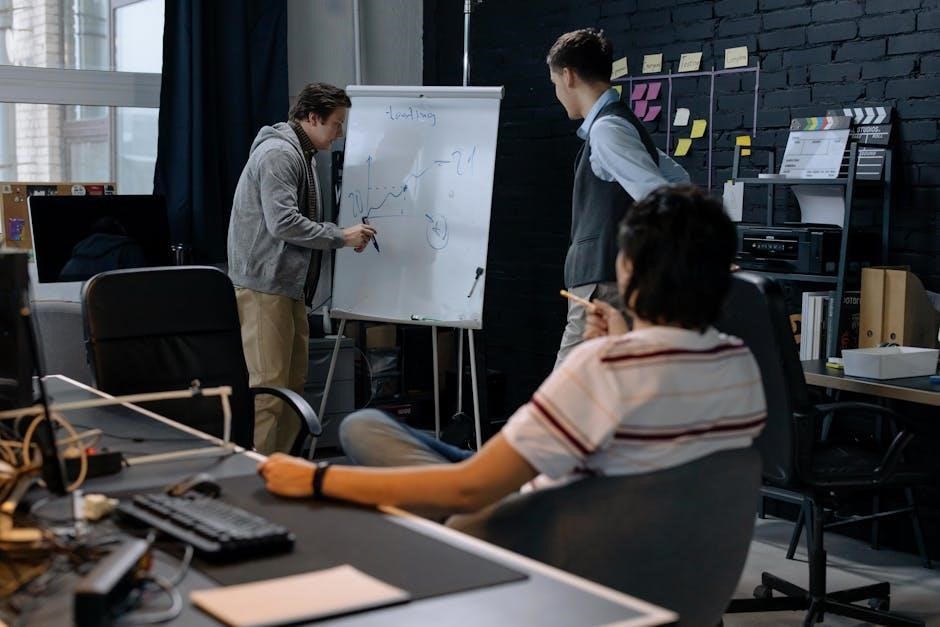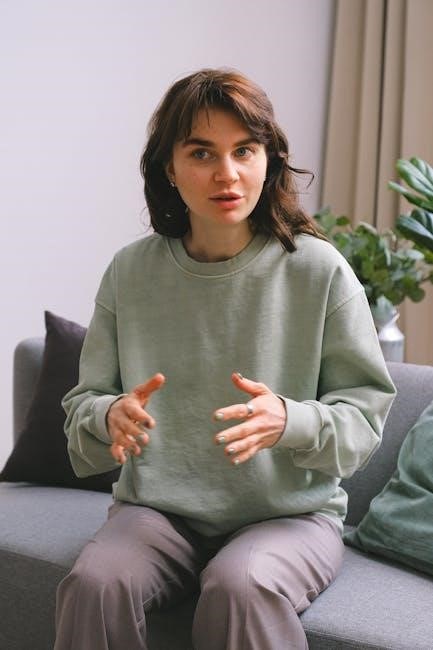
A Problem and Solution Graphic Organizer is a visual tool designed to outline problems and solutions effectively, aiding in structured planning and decision-making processes․
1․1 Definition of a Problem and Solution Graphic Organizer
A Problem and Solution Graphic Organizer is a visual tool that structures the process of identifying, analyzing, and resolving issues․ It typically consists of sections for defining the problem, exploring possible solutions, and selecting the most effective one․ This organizer is designed to simplify complex situations by breaking them down into manageable parts, making it easier to communicate and address challenges systematically․ It is widely used in education, business, and personal planning to enhance clarity and efficiency in problem-solving processes․
1․2 Importance of Graphic Organizers in Problem-Solving
Graphic organizers play a crucial role in problem-solving by providing a structured framework for identifying and addressing issues․ They help individuals and teams break down complex problems into manageable components, making it easier to analyze and resolve them․ By visually organizing information, these tools enhance clarity, collaboration, and communication․ They also ensure that all aspects of a problem are considered, preventing oversights and promoting holistic solutions․ This structured approach fosters creativity, critical thinking, and efficient decision-making, making graphic organizers invaluable in both educational and professional settings․

Structure of a Problem and Solution Graphic Organizer
A problem and solution graphic organizer typically includes sections for the problem, possible solutions, and the final solution, providing a clear framework for organizing thoughts systematically․
2․1 Key Components: Problem, Possible Solutions, and Final Solution
A problem and solution graphic organizer is structured into three primary sections: the problem, possible solutions, and the final solution․ The problem section outlines the issue, often broken down into “what,” “why,” and “who” to clarify its scope․ Possible solutions are generated through brainstorming, with pros and cons analyzed for each option․ Finally, the chosen solution is detailed, including actionable steps and expected outcomes․ This structure ensures a logical flow from identifying the issue to implementing the most effective resolution, making the problem-solving process clear and actionable․
2․2 Visual Representation: How the Organizer is Designed
The problem and solution graphic organizer is visually structured to simplify complex issues․ It typically features boxes, charts, or diagrams that separate the problem, possible solutions, and the final solution․ The design often includes clear sections with headings and subheadings, ensuring each part of the problem-solving process is distinct․ The visual layout uses arrows, lines, or flowcharts to show the progression from identifying the problem to brainstorming solutions and selecting the best one․ This design promotes clarity and makes the information easy to understand and review, enhancing the overall problem-solving experience․

Benefits of Using Problem and Solution Graphic Organizers
Problem and solution graphic organizers simplify complex issues, enhance collaboration, and promote creative thinking, making them invaluable tools for education, business, and personal planning․
3․1 Simplifies Complex Problems
Problem and solution graphic organizers break down intricate issues into manageable parts, making them easier to understand and address․ By visually separating the problem, possible solutions, and final resolution, these tools enable users to focus on each aspect individually․ This structured approach reduces overwhelm, allowing for clearer analysis and more effective decision-making․ Whether in education or professional settings, such organizers provide a straightforward framework for tackling complex challenges, ensuring that all elements of the problem are considered systematically․
3․2 Enhances Collaboration and Communication
Problem and solution graphic organizers foster effective collaboration by providing a shared framework for teams to understand and address issues․ They ensure everyone is aligned, promoting clear communication and reducing misunderstandings․ In educational settings, students can collectively identify problems and brainstorm solutions, enhancing teamwork․ In businesses, these tools facilitate structured discussions, making it easier for teams to outline problems and solutions collectively․ The visual format aids in presenting ideas clearly, allowing all members to contribute and track progress effectively, thus improving overall collaboration and communication in problem-solving processes․
3․3 Promotes Creative Thinking and Brainstorming
Problem and solution graphic organizers stimulate creative thinking by providing a structured format for generating diverse ideas․ The visual layout encourages brainstorming sessions, allowing individuals to explore various solutions․ By separating problems from possible solutions, these tools enable users to think outside the box and evaluate multiple perspectives․ This approach fosters innovation and helps identify unique solutions․ Additionally, the ability to compare pros and cons of each solution enhances critical thinking and decision-making skills, making these organizers invaluable for both educational and professional settings․

Types of Problem and Solution Graphic Organizers
Various types include simple layouts, weekly organizers, and student worksheets, each designed to address problems and solutions in structured, visually appealing formats․
4․1 Simple Problem and Solution Layout
The simple problem and solution layout is a straightforward design featuring three main sections: Problem, Possible Solutions, and Final Solution․ This format is ideal for users who need a clear, easy-to-follow structure․ The problem section allows for a concise description of the issue, while the possible solutions section encourages brainstorming․ The final solution section provides a space to outline the chosen action plan․ This layout is user-friendly, making it perfect for students, educators, and professionals seeking to organize their thoughts effectively․ Its simplicity ensures clarity and focus, making it a versatile tool for various contexts․
4․2 Weekly Problem and Solution Organizer
The Weekly Problem and Solution Organizer is designed for tracking issues and solutions over a five-day period․ Each day is divided into columns for rough work, number sentences, and answers, making it ideal for students to practice problem-solving․ This organizer focuses on daily problem resolution, providing a structured format for teachers to assign and monitor progress․ It is less formal than other organizers, emphasizing routine practice rather than complex problem analysis․ This tool is particularly useful in educational settings to help students develop consistent problem-solving skills and organizational habits․
4․3 Problem and Solution Worksheet for Students
The Problem and Solution Worksheet for Students is an educational tool designed to help students identify and analyze problems and their solutions․ It typically includes scenarios or story elements where students are prompted to highlight or underline the problem and solution․ This worksheet is often used in classrooms to teach critical thinking and comprehension skills․ By breaking down stories into clear sections, students learn to distinguish between challenges and their resolutions, enhancing their understanding of narrative structures and problem-solving abilities․ It is a simple yet effective resource for developing analytical skills in young learners․

How to Create a Problem and Solution Graphic Organizer

Start by defining the problem clearly, then brainstorm possible solutions․ Organize ideas into sections: problem description, possible solutions, and final resolution․ Use templates or design tools to create a visually appealing and structured layout․ Ensure clarity and simplicity for effective communication․
5․1 Step-by-Step Guide to Designing the Organizer
Step 1: Define the problem clearly and concisely․
Step 2: Brainstorm possible solutions and organize them into sections․
Step 3: Choose a layout, such as a chart or map, to visually represent the problem and solutions․
Step 4: Use templates from tools like Canva or EdrawMax for a professional look․
Step 5: Keep the design simple and clear, using colors and shapes for clarity․
Step 6: Consider adding a pros and cons section for solution evaluation․
Step 7: Finalize the design and present it to the team or audience․
This method ensures an effective and user-friendly graphic organizer․
5․2 Tools and Templates for Creating Graphic Organizers
Popular tools for creating graphic organizers include Canva, EdrawMax, and Book Creator, offering customizable templates․
Templates like the Problem & Solution Diagram by EdrawMax simplify design․
Styles such as Blue Tan Lined or Beige and Green Modern provide visually appealing options․
These tools allow users to tailor organizers for education, business, or personal use, ensuring clarity and effectiveness in problem-solving․

Examples of Problem and Solution Graphic Organizers
Examples include the Problem and Solution Diagram by EdrawMax, the Blue Tan Lined graphic organizer, and the Beige and Green Modern table graph, offering diverse visual styles․
6․1 Problem and Solution Diagram by EdrawMax
The Problem and Solution Diagram by EdrawMax is a powerful tool for visually outlining issues and solutions․ It features a structured framework that breaks down problems into key components, such as causes, possible solutions, and final resolutions․ This diagram simplifies complex issues by organizing information clearly, making it easier to brainstorm and select the most effective solution․ Its clean design and user-friendly interface make it ideal for both educational and professional settings, allowing users to present problems and solutions in an easily understandable format․
6․2 Problem and Solution Graphic Organizer in Blue Tan Lined Style
The Problem and Solution Graphic Organizer in Blue Tan Lined Style offers a visually appealing and structured format for outlining issues and their resolutions․ With its clean, professional design, this template is ideal for educational and professional use․ It features distinct sections for problem identification, possible solutions, and final resolution, making it easy to organize thoughts and communicate ideas effectively․ The blue and tan color scheme enhances readability, while the lined structure provides a clear guide for users to systematically address and solve problems․
6․3 Beige and Green Modern Simple Problem and Solution Table Graph
The Beige and Green Modern Simple Problem and Solution Table Graph is a sleek, minimalist template designed for clarity and efficiency․ Created by mulkstudio, this organizer features a clean table format with a soothing beige and green color scheme, enhancing readability․ It is ideal for users who prefer a simple yet professional look․ The table structure allows for clear separation of problems and solutions, making it easy to organize and review information․ This design is perfect for educational, business, or personal use, offering a modern and visually appealing way to address problems and solutions․

Using Problem and Solution Graphic Organizers in Education
Problem and Solution Graphic Organizers are widely used in education to teach students how to identify and address issues systematically, fostering critical thinking and collaboration skills․
7․1 Teaching Students to Identify Problems and Solutions
Problem and Solution Graphic Organizers are invaluable in education, helping students systematically identify and analyze issues․ By breaking down problems into clear components—description, causes, and potential solutions—students develop critical thinking skills․ These tools encourage collaboration, as students can brainstorm and evaluate solutions together․ The structured format fosters clear communication, allowing learners to articulate their thoughts effectively․ Educators use these organizers to guide students in understanding story elements, resolving conflicts, and developing actionable plans․ This approach not only enhances problem-solving abilities but also prepares students for real-world challenges by promoting logical reasoning and creativity․
7․2 Enhancing Story Elements: Problem and Solution Worksheets
Problem and Solution Worksheets are excellent tools for enhancing story elements by guiding students to identify and analyze conflicts and resolutions within narratives․ These worksheets often feature sections for summarizing the problem, its causes, and the eventual solution, helping students understand plot structure and character development․ By focusing on story elements, students improve comprehension and critical thinking skills․ The interactive nature of these worksheets makes learning engaging, allowing students to visualize how problems unfold and solutions emerge in stories․ This approach fosters a deeper appreciation for storytelling and its components․

Problem and Solution Graphic Organizers in Business and Personal Planning
Graphic organizers streamline problem-solving in business and personal planning by visually mapping issues and solutions, enhancing collaboration and strategic goal achievement through structured, actionable frameworks․
8․1 Solving Workplace Issues with Graphic Organizers
Graphic organizers are invaluable in addressing workplace challenges by providing a clear, structured approach to problem-solving․ They enable teams to outline issues, brainstorm solutions, and map out implementation steps visually․ This tool fosters collaboration, ensuring alignment among team members․ By breaking down complex problems into manageable components, graphic organizers simplify decision-making and enhance communication․ They also aid in delegating tasks and tracking progress, making them essential for effective workplace management and strategic planning․ Their visual format ensures clarity, enabling teams to focus on actionable solutions and adapt as needed․
8․2 Personal Goal Setting and Problem Solving
Graphic organizers are powerful tools for personal goal setting and problem-solving, enabling individuals to structure their thoughts and actions visually․ They help identify personal objectives, break them into manageable steps, and map out potential obstacles with solutions․ By visualizing goals and challenges, individuals can prioritize tasks, track progress, and maintain focus․ These organizers also promote self-reflection and accountability, making them ideal for personal development․ Whether addressing daily challenges or long-term aspirations, graphic organizers provide a clear, actionable framework for achieving success․ Their versatility and simplicity make them indispensable for personal planning and growth․

Best Practices for Effective Use
Ensure clarity and simplicity in design, use clear language, and regularly review and update solutions to maintain effectiveness and relevance in problem-solving processes․
9․1 Clarity and Simplicity in Design
Clarity and simplicity are essential for effective use of problem and solution graphic organizers․ Ensure the design is clean, with clear headings and concise language․ Avoid clutter by using bullet points and visuals to break down information․ This makes the organizer easy to read and understand․ Simplify complex problems by focusing on key details․ Use consistent formatting and colors to enhance readability․ Accessibility is also crucial, so avoid overly intricate designs that may confuse users․ A well-structured, straightforward layout ensures that the problem and solution are communicated effectively․
9․2 Regular Review and Update of Solutions
Regularly reviewing and updating solutions in graphic organizers ensures adaptability and effectiveness․ Schedule periodic checks to assess progress and relevance․ Involve teams or stakeholders in reviews to gather diverse insights․ Update solutions based on new information or feedback, ensuring they remain practical and aligned with goals․ This practice fosters continuous improvement and accountability․ Regular updates also help in identifying outdated strategies and refining approaches․ By maintaining a dynamic problem-solving process, graphic organizers become more reliable tools for achieving desired outcomes․ Consistent reviews ensure that solutions evolve with changing circumstances, enhancing overall problem-solving efficiency․ This iterative approach is crucial for long-term success․
10․1 Summary of Key Points
Problem and solution graphic organizers are powerful tools that help individuals and organizations tackle challenges effectively․ They provide a structured framework for identifying problems, brainstorming solutions, and organizing information clearly․ By simplifying complex issues, they enhance collaboration and promote creative thinking․ These organizers are widely used in education, business, and personal planning to improve problem-solving skills and decision-making․ Their versatility allows them to be adapted to various contexts, making them invaluable for teaching, strategic planning, and personal goal setting․ Regular use of these tools fosters a systematic approach to addressing challenges and achieving desired outcomes․
10․2 Encouragement to Implement Graphic Organizers
Start leveraging problem and solution graphic organizers to streamline problem-solving and enhance productivity․ These tools simplify complex issues, foster creativity, and improve communication․ Whether you’re an educator, professional, or student, graphic organizers offer a versatile framework for structured planning․ Customize templates to suit your needs, from classroom activities to workplace strategies․ Regular use can transform how you approach challenges, making solutions clearer and more actionable․ Download PDF templates today and embrace a more organized, efficient approach to tackling problems and achieving your goals․